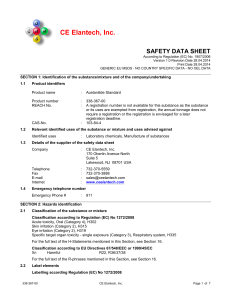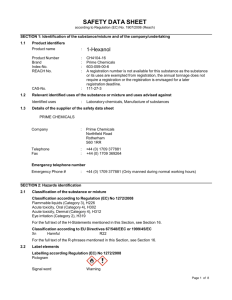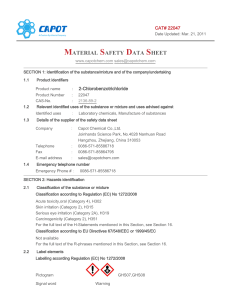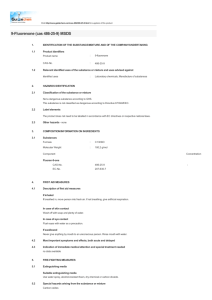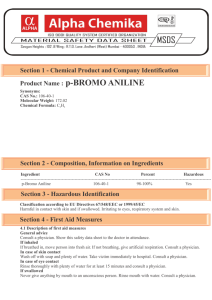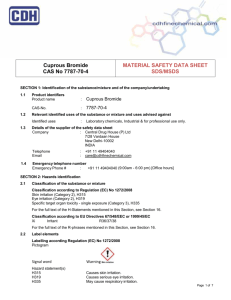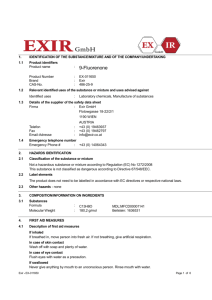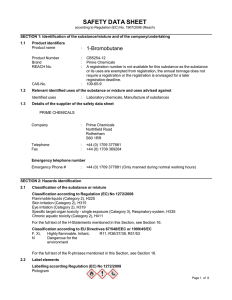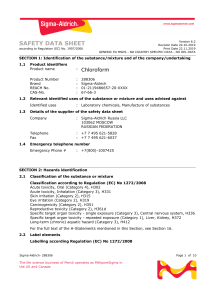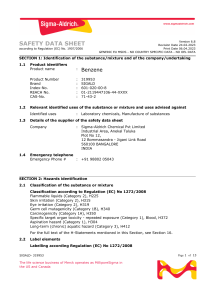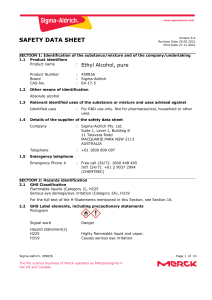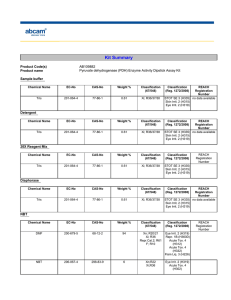2-Phenylethanol
advertisement
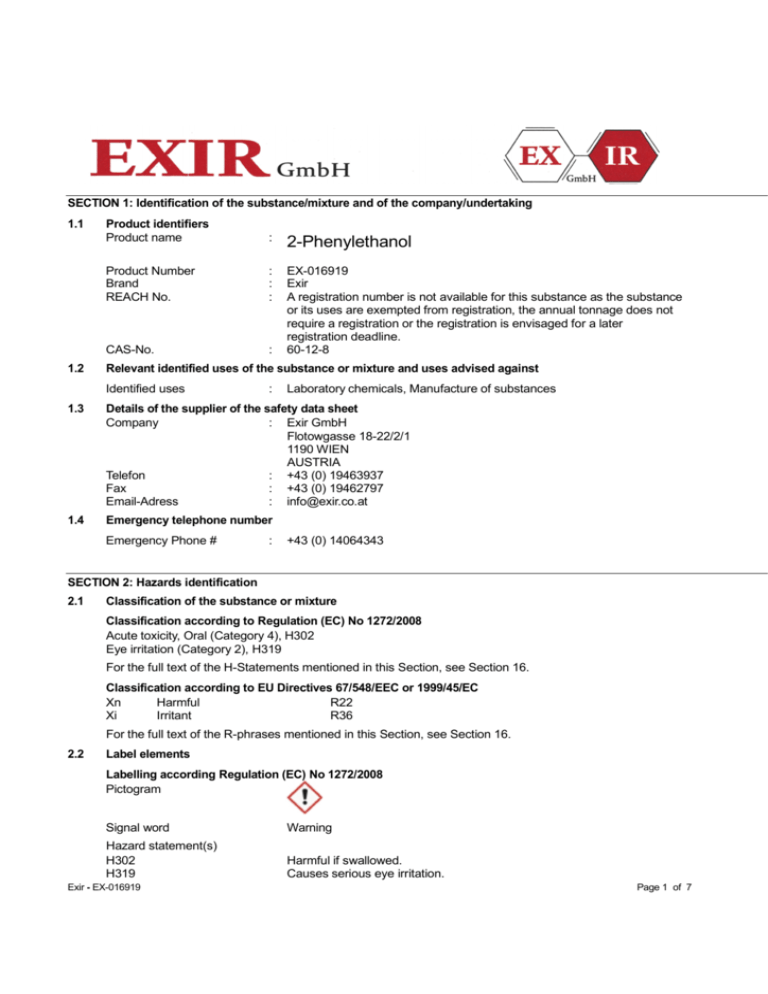
SECTION 1: Identification of the substance/mixture and of the company/undertaking 1.1 1.2 Product identifiers Product name : 2-Phenylethanol Product Number Brand REACH No. : : : CAS-No. : EX-016919 Exir A registration number is not available for this substance as the substance or its uses are exempted from registration, the annual tonnage does not require a registration or the registration is envisaged for a later registration deadline. 60-12-8 Relevant identified uses of the substance or mixture and uses advised against Identified uses : Laboratory chemicals, Manufacture of substances 1.3 Details of the supplier of the safety data sheet Company : Exir GmbH Flotowgasse 18-22/2/1 1190 WIEN AUSTRIA Telefon : +43 (0) 19463937 Fax : +43 (0) 19462797 Email-Adress : info@exir.co.at 1.4 Emergency telephone number Emergency Phone # : +43 (0) 14064343 SECTION 2: Hazards identification 2.1 Classification of the substance or mixture Classification according to Regulation (EC) No 1272/2008 Acute toxicity, Oral (Category 4), H302 Eye irritation (Category 2), H319 For the full text of the H-Statements mentioned in this Section, see Section 16. Classification according to EU Directives 67/548/EEC or 1999/45/EC Xn Harmful R22 Xi Irritant R36 For the full text of the R-phrases mentioned in this Section, see Section 16. 2.2 Label elements Labelling according Regulation (EC) No 1272/2008 Pictogram Signal word Warning Hazard statement(s) H302 H319 Harmful if swallowed. Causes serious eye irritation. Exir - EX-016919 Page 1 of 7 Precautionary statement(s) P305 + P351 + P338 IF IN EYES: Rinse cautiously with water for several minutes. Remove contact lenses, if present and easy to do. Continue rinsing. Supplemental Hazard Statements 2.3 none Other hazards This substance/mixture contains no components considered to be either persistent, bioaccumulative and toxic (PBT), or very persistent and very bioaccumulative (vPvB) at levels of 0.1% or higher. SECTION 3: Composition/information on ingredients 3.1 Substances Synonyms : Benzyl carbinol 2-Phenylethyl alcohol MDL Formula Molecular weight CAS-No. EC-No. : : : : : MFCD00002886 C8H10O 122,16 g/mol 60-12-8 200-456-2 Beilstein: 1905732 Hazardous ingredients according to Regulation (EC) No 1272/2008 Component Classification 2-Phenylethanol CAS-No. EC-No. 60-12-8 200-456-2 Acute Tox. 4; Eye Irrit. 2; H302, H319 Hazardous ingredients according to Directive 1999/45/EC Component Classification 2-Phenylethanol CAS-No. EC-No. 60-12-8 200-456-2 Xn, R22 - R36 Concentration <= 100 % Concentration <= 100 % For the full text of the H-Statements and R-Phrases mentioned in this Section, see Section 16 SECTION 4: First aid measures 4.1 Description of first aid measures General advice Consult a physician. Show this safety data sheet to the doctor in attendance. If inhaled If breathed in, move person into fresh air. If not breathing, give artificial respiration. Consult a physician. In case of skin contact Wash off with soap and plenty of water. Consult a physician. In case of eye contact Rinse thoroughly with plenty of water for at least 15 minutes and consult a physician. If swallowed Never give anything by mouth to an unconscious person. Rinse mouth with water. Consult a physician. 4.2 Most important symptoms and effects, both acute and delayed The most important known symptoms and effects are described in the labelling (see section 2.2) and/or in section 11 4.3 Indication of any immediate medical attention and special treatment needed No data available Exir - EX-016919 Page 2 of 7 SECTION 5: Firefighting measures 5.1 Extinguishing media Suitable extinguishing media Use water spray, alcohol-resistant foam, dry chemical or carbon dioxide. 5.2 Special hazards arising from the substance or mixture Carbon oxides 5.3 Advice for firefighters Wear self-contained breathing apparatus for firefighting if necessary. 5.4 Further information No data available SECTION 6: Accidental release measures 6.1 Personal precautions, protective equipment and emergency procedures Use personal protective equipment. Avoid breathing vapours, mist or gas. Ensure adequate ventilation. For personal protection see section 8. 6.2 Environmental precautions Do not let product enter drains. 6.3 Methods and materials for containment and cleaning up Soak up with inert absorbent material and dispose of as hazardous waste. Keep in suitable, closed containers for disposal. 6.4 Reference to other sections For disposal see section 13. SECTION 7: Handling and storage 7.1 Precautions for safe handling Avoid contact with skin and eyes. Avoid inhalation of vapour or mist. For precautions see section 2.2. 7.2 Conditions for safe storage, including any incompatibilities Store in cool place. Keep container tightly closed in a dry and well-ventilated place. Storage class (TRGS 510): Combustible liquids 7.3 Specific end use(s) Apart from the uses mentioned in section 1.2 no other specific uses are stipulated SECTION 8: Exposure controls/personal protection 8.1 Control parameters Components with workplace control parameters 8.2 Exposure controls Appropriate engineering controls Handle in accordance with good industrial hygiene and safety practice. Wash hands before breaks and at the end of workday. Personal protective equipment Eye/face protection Face shield and safety glasses Use equipment for eye protection tested and approved under appropriate government standards such as NIOSH (US) or EN 166(EU). Skin protection Handle with gloves. Gloves must be inspected prior to use. Use proper glove removal technique (without touching glove's outer surface) to avoid skin contact with this product. Dispose of Exir - EX-016919 Page 3 of 7 contaminated gloves after use in accordance with applicable laws and good laboratory practices. Wash and dry hands. The selected protective gloves have to satisfy the specifications of EU Directive 89/686/EEC and the standard EN 374 derived from it. Full contact Material: butyl-rubber Minimum layer thickness: 0,3 mm Break through time: 480 min Material tested:Butoject® (KCL 897 / Exir Z677647, Size M) Splash contact Material: Nitrile rubber Minimum layer thickness: 0,4 mm Break through time: 30 min Material tested:Camatril® (KCL 730 / Exir Z677442, Size M) data source: KCL GmbH, D-36124 Eichenzell, phone +49 (0)6659 87300, e-mail sales@kcl.de, test method: EN374 If used in solution, or mixed with other substances, and under conditions which differ from EN 374, contact the supplier of the CE approved gloves. This recommendation is advisory only and must be evaluated by an industrial hygienist and safety officer familiar with the specific situation of anticipated use by our customers. It should not be construed as offering an approval for any specific use scenario. Body Protection Complete suit protecting against chemicals, The type of protective equipment must be selected according to the concentration and amount of the dangerous substance at the specific workplace. Respiratory protection Where risk assessment shows air-purifying respirators are appropriate use a full-face respirator with multi-purpose combination (US) or type ABEK (EN 14387) respirator cartridges as a backup to engineering controls. If the respirator is the sole means of protection, use a full-face supplied air respirator. Use respirators and components tested and approved under appropriate government standards such as NIOSH (US) or CEN (EU). Control of environmental exposure Do not let product enter drains. SECTION 9: Physical and chemical properties 9.1 Information on basic physical and chemical properties a) Appearance Form: liquid b) Odour characteristic c) No data available Odour Threshold d) pH 6-7 (20 g/l 20 °C) e) Melting point/freezing point Melting point/range: -65 °C(lit.). f) 219 - 221 °C at 1.000 hPa - lit. Initial boiling point and boiling range g) Flash point 101,5 °C - closed cup h) Evaporation rate No data available i) Flammability (solid, gas) No data available j) Upper/lower flammability or explosive limits 1.4-11.9 Vol% k) Vapour pressure 1 mmHg ( 58 °C),0.08 hPa (20 °C) Exir - EX-016919 Page 4 of 7 l) 9.2 Vapour density 4,22 - (Air = 1.0) m) Relative density 1,02 g/mL at 20 °C n) Water solubility 20 g/l (20 °C) o) Partition coefficient: noctanol/water log Pow: 1.36 p) Auto-ignition temperature 410 °C (DIN 51794) q) Decomposition temperature No data available r) Viscosity 7.58 mPa*s (25 °C) s) Explosive properties No data available t) Oxidizing properties No data available Ethanol: > 500 g/l (20 °C) Other safety information Relative vapour density 4,22 - (Air = 1.0) SECTION 10: Stability and reactivity 10.1 Reactivity No data available 10.2 Chemical stability Stable under recommended storage conditions. May form peroxides on prolonged storage. Date container and periodically test for peroxides. Stable under recommended storage conditions. 10.3 Possibility of hazardous reactions No data available 10.4 Conditions to avoid No data available 10.5 Incompatible materials Strong oxidizing agents, Strong acids 10.6 Hazardous decomposition products Other decomposition products - No data available In the event of fire: see section 5 SECTION 11: Toxicological information 11.1 Information on toxicological effects Acute toxicity LD50 Oral - Rat - 1.790 mg/kg Remarks: Behavioral:Coma. Gastrointestinal disturbance LD50 Dermal - Rabbit - 2.535 mg/kg Skin corrosion/irritation Skin - Guinea pig Result: Mild skin irritation Serious eye damage/eye irritation Eyes - Rabbit Result: Moderate eye irritation Respiratory or skin sensitisation No data available Germ cell mutagenicity No data available Exir - EX-016919 Page 5 of 7 Carcinogenicity IARC: No component of this product present at levels greater than or equal to 0.1% is identified as probable, possible or confirmed human carcinogen by IARC. Reproductive toxicity Developmental Toxicity - Rat - Oral Effects on Embryo or Fetus: Fetal death. Specific Developmental Abnormalities: Musculoskeletal system. Specific Developmental Abnormalities: Urogenital system. Developmental Toxicity - Rat - Oral Specific Developmental Abnormalities: Eye, ear. Specific Developmental Abnormalities: Craniofacial (including nose and tongue). Effects on Newborn: Growth statistics (e.g., reduced weight gain). Developmental Toxicity - Rat - Skin Specific Developmental Abnormalities: Musculoskeletal system. Specific target organ toxicity - single exposure No data available Specific target organ toxicity - repeated exposure No data available Aspiration hazard No data available Additional Information RTECS: SG7175000 Cough, Shortness of breath, Headache, Nausea, Vomiting To the best of our knowledge, the chemical, physical, and toxicological properties have not been thoroughly investigated. SECTION 12: Ecological information 12.1 Toxicity No data available 12.2 Persistence and degradability No data available 12.3 Bioaccumulative potential No data available 12.4 Mobility in soil No data available 12.5 Results of PBT and vPvB assessment This substance/mixture contains no components considered to be either persistent, bioaccumulative and toxic (PBT), or very persistent and very bioaccumulative (vPvB) at levels of 0.1% or higher. 12.6 Other adverse effects No data available SECTION 13: Disposal considerations 13.1 Waste treatment methods Product Offer surplus and non-recyclable solutions to a licensed disposal company. Contaminated packaging Dispose of as unused product. Exir - EX-016919 Page 6 of 7 SECTION 14: Transport information 14.1 UN number ADR/RID: - IMDG: - IATA: - 14.2 UN proper shipping name ADR/RID: Not dangerous goods IMDG: Not dangerous goods IATA: Not dangerous goods 14.3 Transport hazard class(es) ADR/RID: - IMDG: - IATA: - Packaging group ADR/RID: - IMDG: - IATA: - Environmental hazards ADR/RID: no IMDG Marine pollutant: no IATA: no 14.4 14.5 14.6 Special precautions for user No data available SECTION 15: Regulatory information This safety datasheet complies with the requirements of Regulation (EC) No. 1907/2006. 15.1 Safety, health and environmental regulations/legislation specific for the substance or mixture No data available 15.2 Chemical Safety Assessment For this product a chemical safety assessment was not carried out SECTION 16: Other information Full text of H-Statements referred to under sections 2 and 3. Acute Tox. Eye Irrit. H302 H319 Acute toxicity Eye irritation Harmful if swallowed. Causes serious eye irritation. Full text of R-phrases referred to under sections 2 and 3 Xn R22 R36 Harmful Harmful if swallowed. Irritating to eyes. Further information The above information is believed to be correct but does not purport to be all inclusive and shall be used only as a guide. The information in this document is based on the present state of our knowledge and is applicable to the product with regard to appropriate safety precautions. It does not represent any guarantee of the properties of the product. Exir Corporation and its Affiliates shall not be held liable for any damage resulting from handling or from contact with the above product. See www.exir.co.at and/or the reverse side of invoice or packing slip for additional terms and conditions of sale. Exir - EX-016919 Page 7 of 7
